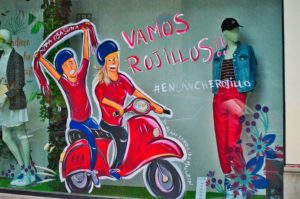4.3: Gramática- El verbo ir
- Page ID
- 184031
Objetivos
- Recognize the correct conjugations of the verb ir
Like the verb ser, the conjugation of ir in the present tense is irregular:
ir (to go)
| Singular | Plural |
|
yo voy |
nosotros vamos |
| tú vas | vosotros vais |
| él / ella / usted va | ellos / ellas / ustedes van |

The verb ir is used to express destinations and will need a preposition to follow it. Add the preposition a after ir to indicate your destination (where you’re going to).
- No voy a la fiesta esta noche porque hay un examen mañana. (I’m not going to the party tonight, because there’s a test tomorrow.)
- Ellos van al gimnasio todos los días. (They go to the gym every day.)

Contracciones
There are only two contractions in the whole Spanish language, and they’re frequently used with ir and other verbs of motion.
A + el = al (to the)
De + el = del (from the)
Be careful, the prepositions a and de only contract with the masculine singular definite article; if you need the feminine or plural form of “the”, it will remain a separate word.
- Vamos al parque con el perro. (We go to the park with the dog.)
- Vamos a los negocios locales. (We go to the local businesses.)
- Los científicos llegan del Instituto de Salud Pública. (The scientists come from the Institute of Public Health.)
- Los maestros llegan de la Universidad Complutense de Madrid. (The teachers come from the Complutense University of Madrid.)
Objetivos
- Recognize the correct conjugations of the verb ir
- Identify where people are going based on spoken text
A.  El verbo ir
El verbo ir
Actividad \(\PageIndex{A}\)
B.  El verbo ir
El verbo ir
Actividad \(\PageIndex{B}\)
Text only
A. El verbo ir
- Yo _____ al cine con Felipe.
- vas
- vais
- voy
- vamos
- Tú _____ a la escuela a las ocho de la mañana.
- vas
- vamos
- va
- vais
- Nosotros _____ al zoológico para ver los tigres.
- vamos
- vais
- voy
- va
- Los amigos _____ a la piscina para nadar.
- van
- vamos
- va
- voy
- La profesora _____ a la escuela para trabajar.
- va
- vais
- vamos
- voy
- Tú _____ al café para tomar un chocolate caliente.
- vas
- va
- vais
- voy
B. El verbo ir
- María ____________ a la escuela para estudiar.
- Jesús y Antonio ____________ al parque para jugar básquetbol.
- El chico ____________ a un partido de fútbol con su padre.
- Nosotros ____________ a un restaurante caro para cenar.
- Vosotras ____________ a un restaurante caro para cenar.
- Yo ____________ a un correo con una carta.
- El profe ____________ a un restaurante caro para cenar.
- Los niños ____________ al supermercado para comprar unas manzanas.
Contributors and Attributions
- 1962 Chevy Nova. Authored by: sv1ambo. Located at: https://www.flickr.com/photos/50415738@N04/8706772190. License: CC BY: Attribution
- Ejercicios: El verbo ir. Authored by: SUNY Oneonta with Lumen Learning. Provided by: SUNY Oneonta. License: CC BY: Attribution
- Ejercicios: El verbo ir. Authored by: Lumen Learning with Freedom Learning Group. License: CC BY: Attribution
- Vamos rojillos. Located at: https://www.maxpixel.net/Street-Navarre-Label-Spain-Showcase-Pamplona-4242577. License: CC0: No Rights Reserved
- El verbo ir en el tiempo presente. Authored by: Deborah M. Edson. Provided by: Tidewater Community College. License: CC BY: Attribution
- contractions. Provided by: SUNY Oneonta with Lumen Learning. License: CC BY: Attribution


